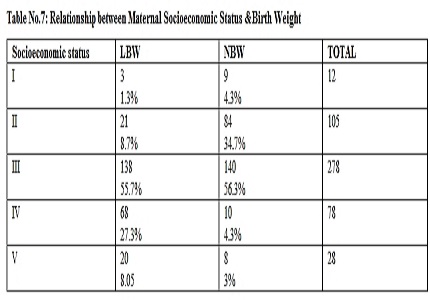To Study the maternal factors which determine the low birth weight babies?
Abstract
Introduction: Birth weight is an important determinant of child survival and development. LBW is closely associated with fetal and perinatal mortality and morbidity. This study was conducted to know the maternal and biosocial factors that influence low birth weight babies.
Material Methods: A case control study carried out with, 500 neonates were selected randomly for the study in which 250 who were LBW babies (<2500 gm) were labeled as cases & 250 equally matched normal birth weight (<2500 gm) were served as control. The variables were subjected to computer analysis using focus format. The data was analysed using a ChiSquare for quantitative data. Chi square test was used to calculate p value. P value was considered significant if <0.05 SPSS version 16 software is used to do the necessary statistical calculations.
Results: maximum number that is 41% of babies were low birth weight with female predominance while male predominance in normal birth weight, maximum number of low birthweight babies were preterm (74.24%) followed by full term & post term , low birth weight babies with increasing frequency was found among mothers below 20 years age group and more than 35 years age group, undernourished mother (<50 kg) and short stature mothers and mother with low socio economic status.
Conclusion: The prevalence of low birth weight was found to be higher and it was associated with young mother, short stature, gestational age <37 wks, presence of any chronic medical illness, maternal weight <50 kg. and short stature. Emphasis should be given to nutritional counseling and disease specific ANC provision by skilled health professionals; Discussions with the community and religious leaders are mandatory aspect on the tradition of feeding of pregnant mothers to tackle the problem. This study also calls for community based further studies.
Downloads
References
2. Taylor HG, Minich NM, Klein N, Hack M. Longitudinal outcomes of very low birth weight: neuropsychological findings. J Int Neuropsychol Soc. 2004 Mar;10(2):149-63.
3. Siza JE. Risk factors associated with low birth weight of neonates among pregnant women attending a referral hospital in northern. Tanzan J Health Res. 2008;10:1–8.
4. Rajaeefard A, Mohammadi M, Choobineh A. Preterm delivery risk factor: a prevention strategy in Shiraz, Islamic Republic of Iran. East Mediterr Health J. 2007;13:17. [PubMed]
5. Zeleke BM, Zelalem M, Mohammed N. Incidence and correlates of low birth weight at a referral hospital in Northwest Ethiopia. Pan Afr Med J. 2012;12:4. Epub 2012 May 4. [PubMed]
6. Dunin-Wasowicz D, Rowecka-Trzebicka K, Milewska-Bobula B, Kassur-Siemieńska B, Bauer A, Idzik M, Lipka B, Marciński P. Risk factors for cerebral palsy in very low-birthweight infants in the 1980s and 1990s. J Child Neurol. 2000 Jun;15(6):417-20.
7. Dharmalingam A, Navaneetham K, Krishnakumar CS. Nutritional status of mothers and low birth weight in India. Matern Child Health J. 2010 Mar;14(2):290-8. doi: 10.1007/s10995-009-0451-8. Epub 2009 Feb 7. [PubMed]
8. Partington SN, Steber DL, Blair KA, Cisler RA. Second births to teenage mothers: risk factors for low birth weight and preterm birth. Perspect Sex Reprod Health. 2009 Jun;41(2):101-9. doi: 10.1363/4110109.
9. Tabcharoen C, Pinjaroen S, Suwanrath C, Krisanapan O. Pregnancy outcome after age 40 and risk of low birth weight. J Obstet Gynaecol. 2009 Jul;29(5):378-83. doi: 10.1080/01443610902929537. [PubMed]
10. Mukhopadhyay P, Chaudhuri RN, Paul B. Hospital-based Perinatal Outcomes and Complications in Teenage Pregnancy in India. J Health Popul Nutr 2010;28:494-500.
11. Roth J, Hendrickson J, Schilling M, Stowell DW. The Risk of Teen Mothers Having Low Birth Weight Babies: Implications of Recent Medical Research for School Health Personnel. J Sch Health 1998;68:271-5.
12. Prudhivi S et al. Maternal factors influencing low birth weight babies. Int J Contemp Pediatr. 2015 Nov;2(4):287-296.
13. Radha Y. Aras Is maternal age risk factor for low birth weight? Archives of Medicine and Health Sciences / Jan-Jun 2013 / Vol 1 | Issue 1. http://www.amhsjournal.org
14. Ganesh Kumar S, Harsha Kumar HN, Jayaram S, Kotian MS. Determinants of low birth weight: a case control study in a district hospital in Karnataka. Indian J Pediatr. 2010 Jan;77(1):87-9. doi: 10.1007/s12098-009-0269-9. [PubMed]
15. Hirve SS, Ganatra BR. Determinants of low birth weight: a community based prospective cohort study. Indian Pediatr. 1994 Oct;31(10):1221-5. [PubMed]
16. Mavalankar DV, Gray RH, Trivedi CR. Risk factors for preterm and term low birthweight in Ahmedabad, India. Int J Epidemiol. 1992 Apr;21(2):263-72. [PubMed]
17. Martínez Contreras AM, Soria Rodríguez CG, Prince Vélez R, Clark Ordoñez I, Medina Ramírez MC. [Preeclampsia: main maternal risk factor for low weight in preterm newborn]. Ginecol Obstet Mex. 2008 Jul;76(7):398-403.
18. Rahman LA. Association between pregnancy induced hypertension and low birthweight; a population based case-control study. Asia Pacific Journal of Public Health. 2008;20(2):152-8.

Copyright (c) 2017 Author (s). Published by Siddharth Health Research and Social Welfare Society

This work is licensed under a Creative Commons Attribution 4.0 International License.


 OAI - Open Archives Initiative
OAI - Open Archives Initiative


